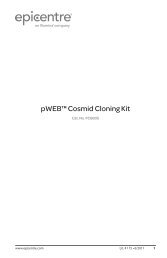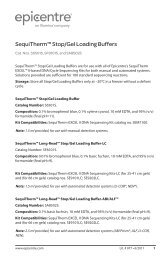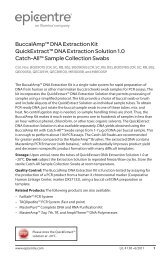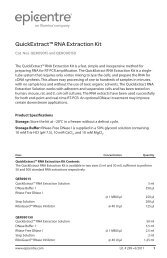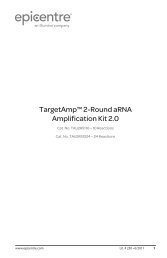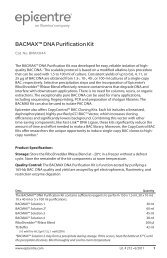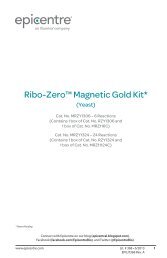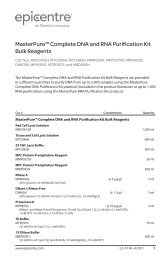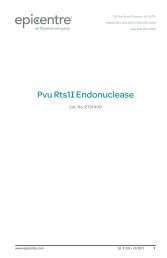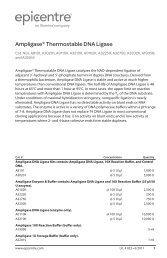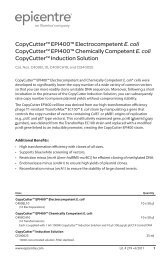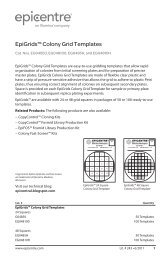Protocol for ScriptSeq⢠Complete Kit (Plant Seed/Root)âLow Input
Protocol for ScriptSeq⢠Complete Kit (Plant Seed/Root)âLow Input
Protocol for ScriptSeq⢠Complete Kit (Plant Seed/Root)âLow Input
Create successful ePaper yourself
Turn your PDF publications into a flip-book with our unique Google optimized e-Paper software.
ScriptSeq <strong>Complete</strong> <strong>Kit</strong> (<strong>Plant</strong> <strong>Seed</strong>/<strong>Root</strong>)–Low <strong>Input</strong>Additional RNA-Seq Sample Prep ProductsRibo-Zero rRNA Removal <strong>Kit</strong>s and Globin-Zero Gold <strong>Kit</strong> <strong>for</strong> globin mRNA/rRNA removal are available separately <strong>for</strong> manysample types, including:Clinical research samplesHuman/Mouse/RatBloodBacteria<strong>Plant</strong>sOtherScriptSeq <strong>Complete</strong> <strong>Kit</strong>s, combining a Ribo-Zero rRNA removal or Globin-Zero globin mRNA/rRNA removal module and aScriptSeq v2 RNA-Seq Library Preparation <strong>Kit</strong> module, are available <strong>for</strong> many sample types, including:Clinical research samplesHuman/Mouse/RatBloodBacteria<strong>Plant</strong>sOther2 www.epicentre.com
ScriptSeq <strong>Complete</strong> <strong>Kit</strong> (<strong>Plant</strong> <strong>Seed</strong>/<strong>Root</strong>)–Low <strong>Input</strong>Total RNARibo-ZerorRNA depletion1.5 hrAAAAAAAAAAAAcDNA synthesis1.5 hr(Single tubeworkflow)3’ Terminal taggingScriptSeq v2PCR andlibrary purification2.5 hrFigure 1. An overview of the ScriptSeq<strong>Complete</strong> <strong>Kit</strong> (<strong>Plant</strong> <strong>Seed</strong>/<strong>Root</strong>)–Low <strong>Input</strong>procedure. rRNA is first removed from thesample using the Ribo-Zero Magnetic <strong>Kit</strong> (<strong>Plant</strong><strong>Seed</strong>/<strong>Root</strong>)–Low <strong>Input</strong>. The ScriptSeq v2 RNA-SeqLibrary Preparation <strong>Kit</strong> is then used to make theRNA-Seq library from the Ribo-Zero treated RNA.The ScriptSeq <strong>Complete</strong> <strong>Kit</strong> (<strong>Plant</strong> <strong>Seed</strong>/<strong>Root</strong>)–Low <strong>Input</strong> is composed of three boxes:– Ribo-Zero rRNA Removal Reagents (<strong>Plant</strong> <strong>Seed</strong>/<strong>Root</strong>)–Low <strong>Input</strong>– Magnetic Core <strong>Kit</strong>–Low <strong>Input</strong>– ScriptSeq v2 RNA-Seq Library Preparation <strong>Kit</strong>1. RNA Sample ConsiderationsDNA-Free RNATreat the RNA sample with DNase I to remove all traces of DNA. Then, remove the DNase I prior to the Ribo-Zero reaction. DNAcontamination will interfere with rRNA removal and is the main cause of loss of directionality when sequencing the ScriptSeq<strong>Complete</strong> library. The RNA sample should be free of salts (e.g., Mg 2+ or guanidinium salts) or organics (e.g., phenol and ethanol).Amount of RNAThe Ribo-Zero process uses 100 ng - 1 µg of DNA-free RNA. The sample should be dissolved in RNase-Free Water or TE Buffer. It isimportant to quantify the amount of total RNA in the sample as accurately as possible in order to use the appropriate amount of Ribo-Zero rRNA Removal Solution in Part 3.B. Use Table 1 (Part 3.B) to determine the maximum volume in which the total RNA sample canbe dissolved prior to per<strong>for</strong>ming the Ribo-Zero procedure.Severely Fragmented RNARibo-Zero treatment of severely fragmented RNA samples does not require any modifications to the procedure presented here.However, the use of severely fragmented RNA does require procedural modifications to the ScriptSeq library preparation procedure.Be sure to read Part 5.A, 5.D, and Appendix 1 be<strong>for</strong>e proceeding.If possible, determine the size distribution of a severely fragmented RNA sample (e.g., Agilent 2100 Bioanalyzer) be<strong>for</strong>e beginning theRibo-Zero procedure. The size of the severely fragmented RNA will determine the best method to purify the ScriptSeq <strong>Complete</strong> libraryin Part 5.F.techhelp@epicentre.com • (800) 284-8474 3
ScriptSeq <strong>Complete</strong> <strong>Kit</strong> (<strong>Plant</strong> <strong>Seed</strong>/<strong>Root</strong>)–Low <strong>Input</strong>Additional Required Reagents and Equipment <strong>for</strong> the ScriptSeq v2 <strong>Kit</strong> procedure:FailSafe PCR Enzyme Mix (Epicentre)Optional: MinElute PCR Purification columns (Qiagen)Optional: Agencourt AMPure XP System (Beckman Coulter) and magnetic plate, rack, or stand <strong>for</strong> 1.5-ml tubesPer<strong>for</strong>mance Specifications and Quality ControlA Ribo-Zero Magnetic <strong>Kit</strong> (<strong>Plant</strong> <strong>Seed</strong>/<strong>Root</strong>)–Low <strong>Input</strong> reaction removes >99% of cytoplasmic (nuclear-encoded) 25S, 18S, 5.8S, and5S; mitochondrial 18S and 5S; chloroplast 23S, 16S, 5S, 4.5S rRNA from 200 ng of soy root RNA, as assessed by qRT-PCR be<strong>for</strong>e and aftera Ribo-Zero Magnetic <strong>Kit</strong> reaction.The ScriptSeq v2 RNA-Seq Library Preparation <strong>Kit</strong> is function-tested in a control reaction using 5 ng of rat liver poly(A) RNA. At least400 ng of a di-tagged library must be produced in a final volume of 20 μl, with a size distribution of 100-1,000 bp, and a peak range of150-300 bp as assayed using an Agilent Bioanalyzer.3. <strong>Kit</strong> ProcedureSection 1: The Ribo-Zero rRNA removal procedureQuick <strong>Protocol</strong> <strong>for</strong> Ribo-Zero <strong>Kit</strong> (<strong>Plant</strong> <strong>Seed</strong>/<strong>Root</strong>)–Low <strong>Input</strong>For experienced users only! The detailed procedure begins at Step 3.AStep Procedure PagesPrepare Magnetic BeadsTreat sample with rRNA RemovalSolutionRemove rRNAAdd 90 µl Magnetic Beads to RNase-free tube.Place in magnetic stand <strong>for</strong> 1 minute at RT.Wash with 90 µl RNase-Free Water.Place in magnetic stand, repeat wash step.Resuspend in 35 µl Resuspension SolutionOptional: Add 0.5 µl RiboGuard RNase InhibitorMix in 20 µl total volume:100 ng - 1 µg total RNA2 - 4 µl rRNA Removal Solution2 µl Reaction BufferIncubate 10 min @ 68˚C, then 5 minutes @ RTMix previously prepared Magnetic BeadsAdd RNA mixture, mix well by pipetting, vortex brieflyIncubate 5 minutes @ RT, vortexIncubate 5 minutes @ 50˚CPlace in magnetic stand, transfer supernatant (rRNA-depletedsample) to RNase-free tubePurify rRNA-depleted sample Ethanol precipitation or alternative method 75673.A. Preparation of the Magnetic BeadsRequired in Part 3.AComponent Name Tube Label Cap ColorMagnetic BeadsRNase-Free WaterMagnetic BeadsRNase-Free WaterMagnetic Bead Resuspension Solution Magnetic Bead Resuspension Solution YellowRiboGuard RNase Inhibitor (100 U/μl) RiboGuard RNase Inhibitor BlueClearImportant! Allow the Magnetic Core <strong>Kit</strong> components to equilibrate to room temperature be<strong>for</strong>e proceeding!Remove the Ribo-Zero rRNA Removal Reagents from –70°C to –80°C storage, thaw the tubes, and place them on ice. Wash the beads byusing either the batch washing or individual washing procedure.techhelp@epicentre.com • (800) 284-8474 5
ScriptSeq <strong>Complete</strong> <strong>Kit</strong> (<strong>Plant</strong> <strong>Seed</strong>/<strong>Root</strong>)–Low <strong>Input</strong>Table 1. Volumes of Ribo-Zero rRNA Removal Solution.Amount of <strong>Input</strong>Total RNAMaximum Volume of TotalRNA That Can Be Added toEach ReactionVolume of Ribo-Zero rRNARemoval Solution Used perReaction100 ng - 250 ng 16 μl 2 μl>250 ng - 1 μg 14 μl 4 μl1. In a 0.2-ml or 0.5-ml RNase-free microcentrifuge tube, combine in the order given:x μl RNase-Free Water2 μl Ribo-Zero Reaction Buffer100 ng - 1 μg Total RNA sample (see Table 1)y μl Ribo-Zero rRNA Removal Solution (see Table 1)20 μl Total volume2. Gently mix the reaction(s) by pipetting and incubate at 68°C <strong>for</strong> 10 minutes. Store the remaining Ribo-Zero rRNA Removal Solutionand Ribo-Zero Reaction Buffer at –70°C to –80°C.3. Remove the reaction tube(s) and incubate each at room temperature <strong>for</strong> 5 minutes.3.C. Magnetic Bead Reaction and rRNA RemovalRequired in Part 3.C: 50°C water bath or heating block <strong>for</strong> 2.0-ml tubes.1. Using a pipette, add the treated RNA from Part 3.B to the 1.5-ml microcentrifuge tube containing the washed Magnetic Beads and,without changing the pipet tip, immediately and thoroughly mix the contents of the tube by pipetting at least 10 times. Then,vortex the tube immediately at medium setting <strong>for</strong> 10 seconds and place at room temperature. Repeat this process <strong>for</strong> eachsample.Important! Always add the treated RNA sample to the washed Magnetic Beads and immediately mix by pipetting. Never add theMagnetic Beads to the treated RNA sample. Immediate and thorough mixing prevents the beads from <strong>for</strong>ming clumps that cansignificantly impact the efficiency of the rRNA removal.2. Incubate the 1.5 ml microcentrifuge tube at room temperature <strong>for</strong> 5 minutes.3. Following incubation, mix the reactions by vortexing at medium speed <strong>for</strong> 10 seconds and then place at 50°C <strong>for</strong> 5 minutes in anappropriate water bath or heating block. Avoid any significant condensation during this incubation step.4. After the 5-minute incubation at 50°C, remove the microcentrifuge tubes and immediately place them on a magnetic stand <strong>for</strong> atleast 1 minute (until the solution appears clear).5. Carefully remove each supernatant (50-52 µl) containing the RNA and transfer to a labeled 1.5-ml RNase-free microcentrifugetube.Important! The supernatant contains rRNA-depleted RNA.Optional: If a small amount of Magnetic Beads are still visible in the supernatant, place the collected supernatant onto the magneticstand <strong>for</strong> 1 minute. Remove the supernatant containing the rRNA-depleted RNA and transfer to a new 1.5-ml RNase-free microcentrifugetube.6. Place the supernatant (RNA solution) on ice and immediately proceed to Part 3.D. Alternatively, the supernatant may be stored at–70°C to –80°C be<strong>for</strong>e completing Part 3.D.3.D. Purification of the rRNA-Depleted SampleThe rRNA-depleted samples can be purified by three methods: ethanol precipitation, AMPure beads, or spin columns. Ethanolprecipitation and the modified RNeasy MinElute procedure provide optimal recovery of small RNAs that may be lost with otherpurification methods; however, ethanol precipitation can be challenging <strong>for</strong> inexperienced users. We also provide an alternativeprotocol using AMPure beads (provided by the user) <strong>for</strong> ease of automation but this will not quantitatively recover small RNAs.3.D.1. Ethanol Precipitation of the rRNA-Depleted SampleComponent Name Tube Label Cap ColorRNase-Free WaterSodium Acetate (3 M)Glycogen (10 mg/ml)RNase-Free WaterSodium AcetateGlycogenCleartechhelp@epicentre.com • (800) 284-8474 7
ScriptSeq <strong>Complete</strong> <strong>Kit</strong> (<strong>Plant</strong> <strong>Seed</strong>/<strong>Root</strong>)–Low <strong>Input</strong>Additionally required <strong>for</strong> each reaction (provided by user):1.5-ml microcentrifuge tube (RNase-free)Ice-cold 70% and 100% ethanol1. Adjust the volume of each sample to 180 μl using RNase-Free Water.2. Add 18 μl of 3 M Sodium Acetate to each tube.3. Add 2 μl of Glycogen (10 mg/ml) to each tube and mix by gentle vortexing.4. Add three volumes (600 μl) of ice-cold 100% ethanol to each tube and mix thoroughly by gentle vortexing.5. Place the tubes at –20°C <strong>for</strong> at least 1 hour.6. Centrifuge the tubes at >10,000 x g in a microcentrifuge <strong>for</strong> 30 minutes. Carefully remove and discard the supernatant.7. Wash the pellet with ice-cold 70% ethanol and centrifuge at >10,000 x g <strong>for</strong> 5 minutes. Carefully remove and discard thesupernatant.8. Repeat Step 7 (above) one more time.9. Centrifuge briefly to collect any residual supernatant. Carefully remove and discard the supernatant and allow the pellet to air dryat room temperature <strong>for</strong> 5 minutes.10. Dissolve the pellet in 10 μl of RNase-Free Water or buffer. The Ribo-Zero-treated RNA can be used immediately or stored at –70°Cto –80°C.3.D.2. Agencourt RNAClean XP <strong>Kit</strong> (Cat. No. A63987, Beckman Coulter)Note: A fresh 80% ethanol solution is required <strong>for</strong> Steps 5 and 7 below.1. Vortex the AMPure RNAClean XP Beads until they are well dispersed, then add as follows:Add 160 μl of the mixed AMPure XP Beads to each 1.5-ml microcentrifuge tube containing 85-90 µl of rRNA-depleted RNA fromPart 3.C, Step 6. Mix thoroughly by gently pipetting the entire volume 10 times.2. Incubate the tube(s) at room temperature <strong>for</strong> 15 minutes. During incubation, prepare 80% ethanol solution required <strong>for</strong> Steps 5and 7.3. Place the tube(s) on the magnetic stand at room temperature <strong>for</strong> at least 5 minutes (until the liquid appears clear).4. Remove and discard the supernatant from each tube. Do not disturb the beads.5. With the tube(s) still on the magnetic stand, add 200 μl of freshly prepared 80% ethanol to each tube, without disturbing thebeads.6. Incubate at room temperature <strong>for</strong> at least 30 seconds while still on the magnetic stand. Then remove and discard all of thesupernatant from each tube. Do not disturb the beads.7. Repeat Steps 5 and 6 (total of two 80% ethanol washes).8. Allow the tubes to air dry on the magnetic stand at room temperature <strong>for</strong> 15 minutes.9. Add 11 µl of RNase-Free water to each tube.10. Thoroughly resuspend the beads by gently pipetting 10 times.11. Incubate the tubes at room temperature <strong>for</strong> 2 minutes.12. Place the tubes back onto the magnetic stand at room temperature <strong>for</strong> at least 5 minutes (until the liquid appears clear).13. Transfer the clear supernatant from each tube to an appropriate collection tube, always leaving at least 1 μl of the supernatantbehind to avoid carryover of magnetic particles. Store on ice <strong>for</strong> immediate use or store at –70°C or –80°C until required.3.D.3. RNeasy MinElute Cleanup <strong>Kit</strong> (Cat. No. 74204, Qiagen)Note: RNA purification kits from other suppliers may also be used; however, per<strong>for</strong>mance may vary.1. Adjust the sample to a volume of 100 μl with RNase-Free Water. Add 350 μl of Buffer RLT, and mix well.2. Add 550 μl of 96%-100% ethanol to the RNA, and mix well by pipetting. Do not centrifuge.3. Transfer half of the sample (~500 µl) to an RNeasy MinElute spin column placed in a 2-ml collection tube (supplied in the Qiagenkit). Close the lid gently, and centrifuge <strong>for</strong> 15 seconds at 8,000 x g (~10,000 rpm). Discard the flow-through. Reuse the collectiontube <strong>for</strong> Step 5.4. Transfer the remaining sample and repeat the centrifugation. Discard the flow-through and collection tube.5. Place the RNeasy MinElute spin column in a new 2-ml collection tube (supplied in the Qiagen kit). Add 500 μl Buffer RPE to thespin column. Close the lid gently, and centrifuge <strong>for</strong> 15 seconds at 8,000 x g (~10,000 rpm) to wash the spin-column membrane.Discard the flow-through.Note: Buffer RPE is supplied as a concentrate. Ensure that ethanol is added to Buffer RPE be<strong>for</strong>e use.6. Add 500 μl of 80% ethanol to the RNeasy MinElute spin column. Close the lid gently, and centrifuge <strong>for</strong> 2 minutes at 8,000 x g(~10,000 rpm) to wash the spin-column membrane. Discard the flow-through and collection tube.8 www.epicentre.com
ScriptSeq <strong>Complete</strong> <strong>Kit</strong> (<strong>Plant</strong> <strong>Seed</strong>/<strong>Root</strong>)–Low <strong>Input</strong>Note: After centrifugation, carefully remove the RNeasy MinElute spin column from the collection tube so that the column does notcontact the flow-through. Otherwise, carryover of ethanol will occur.7. Place the RNeasy MinElute spin column in a new 2-ml collection tube (supplied in the Qiagen kit).8. Open the lid of the spin column, and centrifuge at full speed <strong>for</strong> 5 minutes. Discard the flow-through and collection tube.9. To avoid damage to the spin-column lids, place the spin columns into the centrifuge with at least one empty position betweencolumns. Orient the lids so that they point in a direction opposite to the rotation of the rotor (i.e., if the rotor rotates clockwise,orient the lids counterclockwise).10. It is important to dry the spin-column membrane since residual ethanol may interfere with downstream applications.Centrifugation with the lids open ensures that no ethanol is carried over during RNA elution.11. Place the RNeasy MinElute spin column in a new 1.5-ml collection tube (supplied in the Qiagen kit). Add 12 μl of RNase-Free Waterdirectly to the center of the spin-column membrane. Close the lid gently, and centrifuge <strong>for</strong> 1 minute at full speed to elute theRNA. Recovery is usually 10 μl.The eluted RNA can be used immediately or stored at –70°C to –80°C.4. Be<strong>for</strong>e Proceeding to ScriptSeq v2 Library PreparationIt is not necessary, but if desired the quality of the Ribo-Zero treated RNA can be assessed be<strong>for</strong>e proceeding to the ScriptSeq v2Library prep procedure in Section 2. If assessing the quality of the Ribo-Zero treated RNA using an Agilent 2100 Bioanalyzer, use theAgilent RNA6000 Pico Chip and load 2-4 ng of the Ribo-Zero treated RNA. The Agilent RNA Nano Chip does not provide sufficientsensitivity. Note that if the Ribo-Zero treated RNA was purified by ethanol precipitation in Step 3.D.1, small RNAs such as tRNA arerecovered along with the mRNAs and large noncoding RNAs. There<strong>for</strong>e, the presence of a high proportion of small RNA in the Ribo-Zero treated sample should not be interpreted as degradation of the RNA.For the Ribo-Zero-treated RNA, use Table 2 as a guide to the maximum volume of the purified RNA to use in ScriptSeq v2 librarypreparation. The indicated volume corresponds to to the amount of Ribo-Zero treated RNA typically recovered from 1 ug of total RNA.Note: Ribo-Zero-treated RNA purified by any of the three methods described in Part 3.D will be recovered in approximately 10 µl ofRNase-Free Water.Table 2. Volume of Ribo-Zero-treated RNA to use in ScriptSeq v2 library preparation.RNA Sample<strong>Plant</strong> <strong>Seed</strong> or <strong>Root</strong>Amount of Total RNA Used in theRibo-Zero ProcedureMaximum Volume of Purified Ribo-Zero-Treated RNA <strong>for</strong> ScriptSeq v2 Reaction1 µg 9 µl500 ng 9 µl100 ng 9 µltechhelp@epicentre.com • (800) 284-8474 9
ScriptSeq <strong>Complete</strong> <strong>Kit</strong> (<strong>Plant</strong> <strong>Seed</strong>/<strong>Root</strong>)–Low <strong>Input</strong>5'500 pg to 50 ng rRNA-depleted Ribo-Zero treated or poly(A) RNA + RNA(AAAA)Random Hexamer withTagging Sequence3' NNNNNNTaggingSequenceFragment RNAAnneal cDNA Synthesis PrimerSynthesize cDNA5'3' NNNNNN3'NNNNNN(AAAA)Remove RNA3' 5'Terminal-Tagging Oligo (TTO)3'-end blocked 5' NNNNNXTaggingSequenceAnneal TTOSynthesize DNA5' NNNNNX3' 5'Purify cDNADi-tagged cDNA3' 5'PCR PrimersAmplify by PCRIndex/Bar Code (optional)5' 3'3' 5'Adaptor-tagged RNA-Seq library<strong>for</strong> directional sequencingBar Code(optional)Figure 2. An overview of the procedure <strong>for</strong> the ScriptSeq v2 RNA-Seq Library Preparation <strong>Kit</strong>.10 www.epicentre.com
Section 2. The ScriptSeq v2 RNA-Seq Library Preparation ProcedureQuick <strong>Protocol</strong> <strong>for</strong> ScriptSeq v2 RNA-Seq Library Preparation <strong>Kit</strong>For experienced users only! The detailed procedure begins at Step 5.Step Procedure PagesFragment RNA If using RNA from FFPE or severely degraded samples, go to Appendix 1.1. Mix the following:x µl Nuclease-Free Watery µl Ribo-Zero treated RNA (See Table 2, pg. 9)1 µl RNA Fragmentation Solution2 µl cDNA Synthesis Primer12Synthesize cDNATerminal-Tag cDNA12 µl Total volume2. Incubate at 85°C <strong>for</strong> 5 minutes in thermocycler then place on ice.1. Mix the following:3.0 µl cDNA Synthesis PreMix0.5 µl 100 mM DTT0.5 µl StarScript Reverse Transcriptase4 µl Total Volume of cDNA Synthesis Master Mix2. Add 4 µl of cDNA Synthesis Master Mix to each reaction. Mix by pipetting.3. Incubate at 25°C <strong>for</strong> 5 min followed by 42°C <strong>for</strong> 20 min.4. Cool reaction to 37°C.5. Add 1.0 µl of Finishing Solution to each reaction. Mix by pipetting.6. Incubate at 37°C <strong>for</strong> 10 min.7. Incubate at 95°C <strong>for</strong> 3 min, cool to 25°C and Pause the thermocycler.1. Mix the following:7.5 µl Terminal Tagging Premix0.5 µl DNA Polymerase8.0 µl total volume of Terminal Tagging Master MixSolution is viscous! Mix thoroughly by pipetting.2. Add 8.0 µl of Terminal Tagging Master Mix to each reaction. Mix by pipetting.3. Incubate reaction at 25°C <strong>for</strong> 15 minutes.4. Incubate reaction at 95°C <strong>for</strong> 3 minutes. Cool to 4°C. The cDNA is now di-tagged.1213Purify cDNA Choose Qiagen MinElute or Agencourt AMPure purification. Elute in 22.5 µl. 13PCRIf adding optional barcodes, go to p. 14 of protocol and skip this Quick Reference <strong>Protocol</strong>.If not adding barcodes:Mix in a 0.2-ml PCR tube:22.5 µl di-tagged cDNA25 µl FailSafe PCR PreMix E1 µl Forward PCR Primer1 µl Reverse PCR Primer0.5 µl FailSafe PCR Enzyme50 µl total volume14Purify LibraryPCR cycle conditions:Denature the dsDNA at 95°C <strong>for</strong> 1 minute followed by 15 cycles of:95°C <strong>for</strong> 30 seconds55°C <strong>for</strong> 30 seconds68°C <strong>for</strong> 3 minutesIncubate at 68°C <strong>for</strong> 7 minutes after the final cycleAMPure purification. Qiagen purification only suggested <strong>for</strong> very short FFPE or severely degradedRNA samples (
ScriptSeq <strong>Complete</strong> <strong>Kit</strong> (<strong>Plant</strong> <strong>Seed</strong>/<strong>Root</strong>)–Low <strong>Input</strong>5. ScriptSeq <strong>Kit</strong> ProcedureRemove all components except enzymes and Finishing Solution, allow to thaw, and store on ice. Centrifuge briefly to collect liquidat bottom of tube. It is highly recommended that enzyme solutions and Finishing Solution be stored in a benchtop cooler (–20˚C) toavoid repeated freeze-thaws.5.A. Fragment the RNA and Anneal the cDNA Synthesis PrimerImportant!1. If using severely fragmented RNA, such as that obtained from FFPE samples, use the procedure described inAppendix 1.Required in Part 5.A.2. The RNA can be fragmented by methods other than those described in Part 5.A. If fragmenting the RNA by othermethods, the fragmented RNA must be purified and dissolved in a maximum of 9 μl of Nuclease-Free Water. Then, usethe procedure described in Appendix 1 to anneal the cDNA synthesis primer and per<strong>for</strong>m cDNA synthesis.Component Name Tube Label Cap ColorcDNA Synthesis PrimerRNA Fragmentation SolutioncDNA PrimerFragmentation SolutionGreenNuclease-Free Water Nuclease-Free Water Clear1. In a 0.2-ml PCR tube, assemble the following reaction mixture. If a “no template” control reaction is per<strong>for</strong>med, substituteNuclease-Free Water <strong>for</strong> the RNA sample.x μl Nuclease-Free Watery μl Ribo-Zero-treated RNA (See Table 2, pg. 9)1 μl RNA Fragmentation Solution2 μl cDNA Synthesis Primer12 μl Total reaction volume2. Fragment RNA: Incubate at 85°C <strong>for</strong> 5 minutes in a thermocycler.3. Stop the fragmentation reaction by placing the tube on ice.85°C5.B. Synthesize cDNARequired in Part 5.B.5:00Component Name Tube Label Cap ColorcDNA Synthesis PreMixcDNA PreMix100 mM DTT 100 mM DTTStarScript Reverse TranscriptaseScriptSeq Finishing SolutionThermocycler settings <strong>for</strong> Part 5.B:25°C <strong>for</strong> 5 minutes (cDNA synthesis)42°C <strong>for</strong> 20 minutes (cDNA synthesis)37°C PauseStarScript Reverse TranscriptaseFinishing Solution37°C <strong>for</strong> 10 minutes (Finishing Solution)95°C <strong>for</strong> 3 minutes (Inactivate Finishing Solution)25°C Pause1. On ice, prepare the cDNA Synthesis Master Mix:For each reaction, combine on ice:3.0 μl cDNA Synthesis PreMix0.5 μl 100 mM DTT0.5 μl StarScript Reverse Transcriptase4.0 μl Total volumeGently but thoroughly mix the cDNA Synthesis Master Mix by pipetting.2. Add 4 μl of the cDNA Synthesis Master Mix to each reaction on ice from Part 5.A, Step 3, and mix by pipetting.Red12 www.epicentre.com
ScriptSeq <strong>Complete</strong> <strong>Kit</strong> (<strong>Plant</strong> <strong>Seed</strong>/<strong>Root</strong>)–Low <strong>Input</strong>3. Incubate at 25°C <strong>for</strong> 5 minutes followed by 42°C <strong>for</strong> 20 minutes.4. Cool the reactions to 37°C and Pause the thermocycler.5. Remove one reaction at a time from the thermocycler, add 1.0 µl of Finishing Solution,and mix gently but thoroughly by pipetting. Return each reaction to the thermocyclerbe<strong>for</strong>e proceeding with the next.6. Incubate at 37°C <strong>for</strong> 10 minutes.7. Incubate each reaction at 95°C <strong>for</strong> 3 minutes. Then, cool the reactions to 25°C andPause the thermocycler.During the 95°C incubation, prepare the Terminal Tagging Master Mix as described inPart 5.C, Step 1.5.C. 3′-Terminal-Tag the cDNARequired in Part 5.C.Component Name Tube Label Cap ColorScriptSeq v2 Terminal-Tagging PremixDNA PolymeraseTagging PreMixDNA PolymeraseImportant! The Terminal-Tagging PreMix is a viscous solution. Mix it thoroughly be<strong>for</strong>e use by pipetting.Thermocycler settings <strong>for</strong> Part 5.C:25°C <strong>for</strong> 15 minutes (DNA Polymerase)95°C <strong>for</strong> 3 minutes (Inactivate DNA Polymerase)4°C Hold or iceBlue42°C25°C37°C5:00 20:00 Pause37°C 95°C25°C10:00 3:00 Pause1. On ice, prepare the Terminal Tagging Master Mix.For each reaction, combine on ice:7.5 μl Terminal Tagging Premix0.5 μl DNA Polymerase8 μl Total volumeThoroughly mix the viscous Terminal Tagging Master Mix by pipetting up and down several times or by flicking the tube.2. Remove one reaction at a time from the thermocycler (from Part 5.B, Step 7) and add 8.0 μl of the Terminal Tagging Master Mix.Gently but thoroughly mix the reaction by pipetting.Return each reaction to the thermocycler be<strong>for</strong>e proceeding with the next.3. Incubate each reaction at 25°C <strong>for</strong> 15 minutes.25°C 95°C4. Incubate each reaction at 95°C <strong>for</strong> 3 minutes. Then, cool the reactions to 4°C on ice orin the thermocycler.5.D. Purify the cDNAThe cDNA must be purified prior to PCR amplification. We recommend using the MinElute PCR Purification <strong>Kit</strong> (Qiagen) or theAgencourt AMPure XP system (BeckmanCoulter). If working with FFPE or severely degraded RNA
ScriptSeq <strong>Complete</strong> <strong>Kit</strong> (<strong>Plant</strong> <strong>Seed</strong>/<strong>Root</strong>)–Low <strong>Input</strong>2. Per<strong>for</strong>m PCR:15 cyclesDenature the ds DNA at 95°C <strong>for</strong> 1 minuteFollowed by 15 cycles* of:95°C <strong>for</strong> 30 seconds55°C <strong>for</strong> 30 seconds68°C <strong>for</strong> 3 minutes*Fewer PCR cycles can be per<strong>for</strong>medAfter the appropriate number of PCR cycles, incubate at 68°C <strong>for</strong> 7 minutes.During the PCR, read Part 5.F to determine which post-PCR purification procedure is best suited to your sample. After the PCRprocedure is complete, proceed immediately to Part 5.F.5.F. Purify the RNA-Seq LibraryUse the AMPure XP system (Beckman Coulter) to purify the ScriptSeq v2 kit libraries, except <strong>for</strong> libraries prepared from FFPE or severelydegraded RNA with an average size
ScriptSeq <strong>Complete</strong> <strong>Kit</strong> (<strong>Plant</strong> <strong>Seed</strong>/<strong>Root</strong>)–Low <strong>Input</strong>6. AppendicesAppendix 1: Preparing a Library from Severely Fragmented RNAUse this procedure when preparing libraries of Ribo-Zero treated RNA:• That is highly fragmented, such as sometimes obtained from FFPE samples.• That has been fragmented using a procedure different than that described in Part 5.A.6.1.A. Anneal the cDNA Synthesis PrimerRequired in Part 6.1.A.Component Name Tube Label Cap ColorcDNA Synthesis Primer cDNA Primer GreenNuclease-Free Water Nuclease-Free Water Clear1. If a “no template” control reaction is per<strong>for</strong>med, substitute Nuclease-Free Water <strong>for</strong> the RNA sample.x μl Nuclease-Free Watery μl Ribo-Zero treated FFPE RNA (See Table 2, pg. 9)2 μl cDNA Synthesis Primer11 μl Total volume2. Incubate at 65°C <strong>for</strong> 5 minutes in a thermocycler.3. Stop the reaction by placing the tube on ice.6.1.B. Synthesize cDNARequired in Part 6.1.B.65°C5:00Component Name Tube Label Cap ColorRNA Fragmentation Solution Fragmentation Solution GreencDNA Synthesis PremixcDNA PreMix100 mM DTT 100 mM DTTStarScript Reverse TranscriptaseStarScript Reverse TranscriptaseRedScriptSeq Finishing SolutionFinishing SolutionNuclease-Free Water Nuclease-Free Water ClearThermocycler settings <strong>for</strong> Part 6.1.B:25°C <strong>for</strong> 5 minutes (cDNA synthesis)42°C <strong>for</strong> 20 minutes (cDNA synthesis)37°C Pause37°C <strong>for</strong> 10 minutes (Finishing Solution)95°C <strong>for</strong> 3 minutes (Inactivate Finishing Solution)25°C PauseNote: The RNA Fragmentation Solution is added to supplement Mg 2+ in the cDNA synthesis reaction.1. Prepare the cDNA Synthesis Master Mix.For each reaction, combine on ice:1.0 μl Fragmentation Solution3.0 μl cDNA Synthesis Premix0.5 μl 100 mM DTT0.5 μl StarScript Reverse Transcriptase5 μl Total volumeGently but thoroughly mix the cDNA Synthesis Master Mix by pipetting 10 times.2. Add 5 μl of the cDNA Synthesis Master Mix to each reaction on ice from Part 6.1.A, Step 3 and mix gently but thoroughly.16 www.epicentre.com
ScriptSeq <strong>Complete</strong> <strong>Kit</strong> (<strong>Plant</strong> <strong>Seed</strong>/<strong>Root</strong>)–Low <strong>Input</strong>3. Incubate at 25°C <strong>for</strong> 5 minutes followed by 42°C <strong>for</strong> 20 minutes.4. Cool the reactions to 37°C and pause the thermocycler.5. Remove one reaction at a time from the thermocycler, add 1.0 µl of Finishing Solution,and mix gently but thoroughly by pipetting. Return each reaction to the thermocyclerbe<strong>for</strong>e proceeding with the next.6. Incubate at 37°C <strong>for</strong> 10 minutes.7. Incubate each reaction at 95°C <strong>for</strong> 3 minutes. Then, allow the reactions to cool to 25°C andPause the thermocycler.During the 95°C incubation, prepare the Terminal Tagging Master Mix as described inPart 5.C, Step 1.8. Continue with the standard kit procedure beginning at Part 5.C.42°C25°C37°C5:00 20:00 Pause37°C 95°C25°C10:00 3:00 PauseAppendix 2: Sequencing a ScriptSeq v2 LibraryNote: Oligonucleotide sequences © 2006-2010 Illumina, Inc. All rights reserved.ScriptSeq RNA-Seq libraries are compatible with TruSeq Cluster <strong>Kit</strong>s and can be sequenced on GAII, HiSeq and MiSeq sequencers.Rd 2 SPTCTAGCCTTCTCGTGTGCAGACTTGAGGTCAGTG 5’5’ AATGATACGGCGACCACCGAGATCTACACTCTTTCCCTACACGACGCTCTTCCGATCT ---cDNA (sense orientation)------- AGATCGGAAGAGCACACGTCTGAACTCCAGTCAC(Barcode)ATCTCGTATGCCGTCTTCTGCTTG 3’3’ TTACTATGCCGCTGGTGGCTCTAGATGTGAGAAAGGGATGTGCTGCGAGAAGGCTAGA---cDNA (antisense orientation)--- TCTAGCCTTCTCGTGTGCAGACTTGAGGTCAGTG(Barcode)TAGAGCATACGGCAGAAGACGAAC 5’5’ ACACTCTTTCCCTACACGACGCTCTTCCGATCTRd 1 SP➞➞5’ GATCGGAAGAGCACACGTCTGAACTCCAGTCACIndex SP➞Figure 3. Sequencing a ScriptSeq v2 library.Red = sequence incorporated by the Terminal Tagging process and PCR amplification.Blue = sequence incorporated during reverse transcription and PCR amplification.Black = sequence of the cDNA.Rd 1 SP = sequence generated is that of the sense strand of the original fragmented RNA molecule.Rd 2 SP = sequence generated is that of the antisense strand of the original fragmented RNA molecule.Index SP = first nucleotide read is that of the Index or barcode.Appendix 3: Adding a User-Defined Barcode to the LibraryNote: Some nucleotide sequences shown in Appendix 3 are copyrighted to Illumina, Inc. Oligonucleotide sequences ©2006-2010 Illumina, Inc. All rights reserved.A barcode is added by the Reverse PCR Primer in Part 5.E of the procedure. A Reverse PCR Primer containing a user-defined barcodesequence must be synthesized by the user and is then used as the Reverse PCR Primer in Part 5.E of the procedure.The user-defined Reverse PCR Primer(s) must be the following sequence:5’ CAAGCAGAAGACGGCATACGAGAT desired barcode’s GTGACTGGAGTTCAGACGTGTGCTCTTCCGATCT 3’reverse complementThe primer(s) should be dissolved to a concentration of 10 μM in nuclease-free water.Important! The user-defined barcode sequence of the of the custom synthesized Reverse PCR Primer should be the reverse complement of thesequence read. For example, using the Illumina Multiplexing Index Read Sequencing Primer, the user-defined barcode sequence:5’…ACGTAC… 3’ will be read as: 5’…GTACGT…3’Please contact Epicentre’s Technical Support if you have questions about adding user-defined barcodes or synthesizing custom reversePCR primers.FailSafe, Globin-Zero, Ribo-Zero, ScriptMiner, ScriptSeq, and StarScript are trademarks of Epicentre, Madison, Wisconsin.Illumina is a registered trademark and TruSeq, HiSeq, and MiSeq are trademarks of Illumina Inc., San Diego, Cali<strong>for</strong>nia.AMPure is a registered trademark of Beckman Coulter, Inc., Danvers, Massachusetts.MinElute is a registered trademark of Qiagen Inc., Valencia, Cali<strong>for</strong>nia.Visit our technical blog: epicentral.blogspot.comtechhelp@epicentre.com • (800) 284-8474 17




